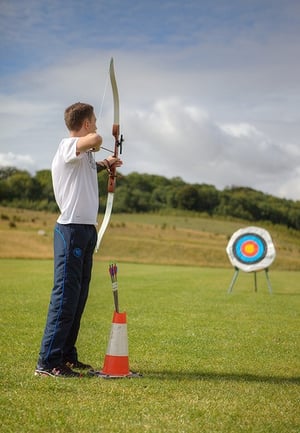Real Life Archery Injuries: A young boy was shot in the eye during target practice at an archery range. He and a friend were unsupervised and taking turns shooting at a target, but it was windy so the target kept falling over. One of the boys went to hold the target while his friend took his turn to shoot at it. His friend missed the target and the arrow struck him directly in the eye. Luckily, the arrow did not penetrate any further into his skull, but the young boy did lose his eye.
Archery Statistics
- There are an estimated 6,800,000 archery participants in the United States every year
- The vast majority of these are youths aged 6-14 at summer camps
- Every year there are approximately 4,300 archery-related injuries requiring emergency room care
- The most common type of injury is abrasion from either the arrow or bowstring
Shooting Safety
Inspecting a Bow and Arrow
Even before nocking an arrow it is important to make sure that all equipment is inspected and in safe working order. A major cause of archery-related accidents comes from damaged bows or bow strings snapping. Make sure to check all components of both the bow and arrow for any signs of damage including cracks, chips, fraying, warping and any other wear and tear that could compromise the integrity of the equipment.
Proper Archery Attire
While not always considered, it is important to make sure all archery participants are properly dressed for the activity.  Participants should not wear anything that could get tangled in the bow. Never wear scarves, hoods, jewelry, or anything excessively loose. There have been cases of necklaces, bracelets, and earrings getting caught in a fired arrow and causing serious injuries.
Participants should not wear anything that could get tangled in the bow. Never wear scarves, hoods, jewelry, or anything excessively loose. There have been cases of necklaces, bracelets, and earrings getting caught in a fired arrow and causing serious injuries.
Safely Firing a Bow
To ensure safety, all archers should load, aim, shoot, and retrieve arrows at the same time. This will ensure that no one is accidently shooting while someone is on the range retrieving arrows. Most archery ranges use the same system to control shooting and retrieving. Typical archery rules use a system of whistles to signify the appropriate action. One whistle blow means you can shoot, two means you can approach the shooting line, and three means you can go retrieve the arrows you have shot. Other important things to consider when shooting is to never load your arrow onto your bow with people in front of you. Make sure to never stand in front of a loaded bow.
Retrieving Arrows
Make sure all archers wait to retrieve arrows until they are signaled to do so. If an archer misfires their arrow and it doesn’t go very far, they are often tempted to quickly retrieve it so they can fire again. It is important to reiterate safety and discourage this behavior. Archers should not bring their bow with them onto the range and should safely set them down after they are done shooting. Make sure all archers have returned to the line from the range and that the range is all clear before signaling it is ok to shoot again. Pay special attention for archers whose arrow may have gone beyond the target as they can be overlooked before the signal to shoot again is given.
Archery Range Safety
The Ideal Archery Range Design
Archery ranges should be well marked and organized so all archers and observers know exactly where to stand when shooting. Grass should be trimmed so arrows can be found easily. Most standard camp archery ranges have the firing line located about 10 yards from the targets. This means that there should be at least 10 yards on each side of the range that is restricted to protect from poor shots or deflected arrows. The range itself should also be as flat as possible and free from obstructions like roots, rocks, stumps, and more. Campers are far more likely to be injured tripping on their way to retrieve arrows than be struck by an arrow. Also, arrows will occasionally stick in the ground and if a child were to trip onto them they could be seriously injured. Signs and fencing should be used to direct people away from the archery range.
Archery Range Buffer Zones
Due to the hazards archery can pose, archery ranges should be in relatively secluded areas where there is no chance of an individual accidently entering the range while participants are shooting. Publicly accessible areas like walkways or trails should be at least 150 yards from all possible trajectories of an arrow. In rare circumstances an archery range may offer bows that can shoot in excess of 150 yards. In these instances, increase the buffer zone to the maximum possible range of the furthest firing bow.
Security
Another concern for archery ranges is security. It is especially important to keep all bows and arrows stored in a locked and secure location. Less mature archers may be tempted to engage in shooting activities without supervision. Supervision is one of the most important safety precautions concerning archery, which is why no camper should be able to engage in archery without direct counselor supervision.
Archery Backdrops
Archery ranges should be equipped with some form of backstop to prevent errant arrows from traveling too far beyond the target. This safety feature is important for two reasons. First, it protects any individuals that inadvertently wander behind the range. Backdrops also make it much easier to find and collect fired arrows. A number of archery range injuries occur when participants spend too much time looking behind the targets for arrows and get struck by the other participants who already collected their arrows and fired again.




